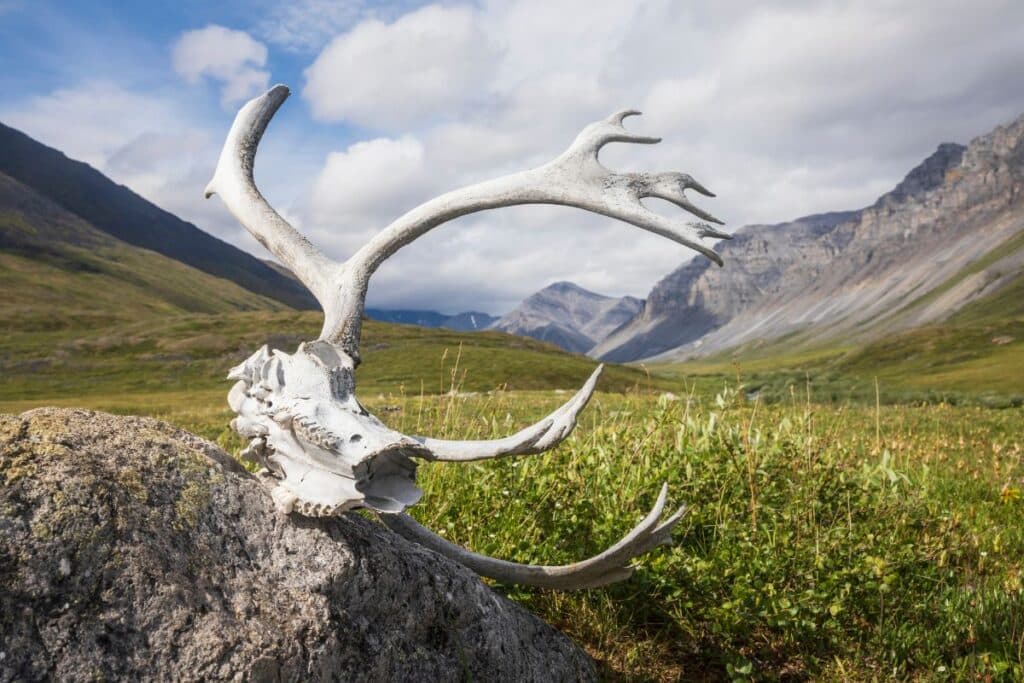Explore 22 animals in The Gates of the Arctic National Park through our hiking experiences
Pack your sense of adventure as we whisk you away to The Gates of the Arctic National Park, a land where animals outnumber people and the untamed wilderness reigns.
Here, caribou forge ancient trails through the tundra, and the sharp-eyed lynx prowls silently in the shadows. Imagine the thrill of encountering a majestic moose or hearing the distant howl of a gray wolf under the wide Arctic sky.
Each step through this remote paradise brings you face-to-face with some of the most resilient wildlife on Earth.
In this article, we’re not just walking you through the park—we’re revealing the secret lives of its 22 most captivating animal inhabitants. Get ready to meet the furry, feathered, and stealthy residents of one of America’s last true frontiers.
Overview of Gates of the Arctic National Park
Before we delve into the fascinating journey I embarked on through the enchanting Gates of the Arctic National Park, it’s essential to familiarize yourself with this phenomenal realm of nature.
Gates of the Arctic National Park, located in the heart of Alaska, is an untouched frontier that stretches over 8.4 million acres.
This makes it the second largest national park in the United States, only slightly smaller than Wrangell-St. Elias National Park and Preserve. One of the most distinctive features of this park is the lack of any roads leading to it or within it.
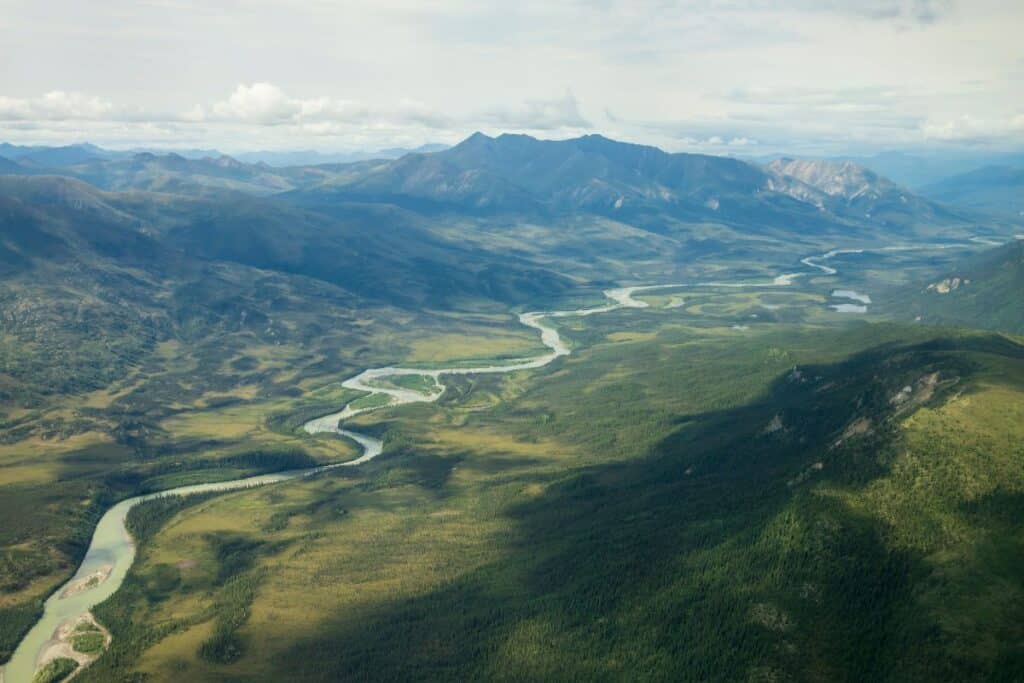
The only way to access it is through a flight or an adventurous hike, making it a sanctuary of pure, untamed wilderness.
The park, fittingly named after two majestic mountains, Frigid Crags and Boreal Mountain, forming a gateway into the icy Arctic landscapes, offers an astounding plethora of wildlife, lush flora, and stunning geological features.
From its colossal peaks and deep valleys, to meandering rivers, shimmering lakes, and spectacular glaciers, it’s a nature lover’s paradise.
It is also a culturally significant region, home to the Iñupiat, Yupik, and Athabascan Native American people, where ancient traditions echo through the wilderness.
22 Animals in the Gates of the Arctic National Park
On our ventures into this sprawling wilderness, we were privileged to encounter an array of fascinating creatures, each contributing to the park’s rich biodiversity. Here are the some remarkable species we sighted.
Caribou
The Gates of the Arctic National Park serves as the grand stage for one of the most phenomenal wildlife spectacles – the migration of the Caribou. Often seen in large herds, Caribous are an integral part of the Arctic ecosystem.
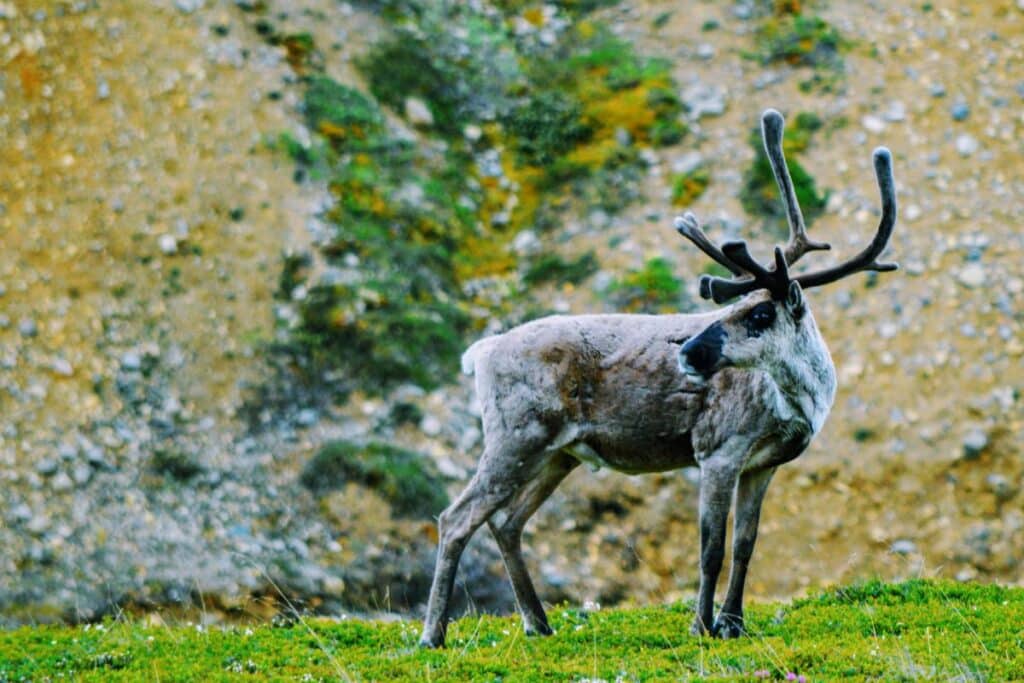
Each year, they make an arduous journey across the park’s expanses, covering hundreds of miles between their summer and winter habitats.
These migrations are driven by the need for suitable calving grounds and the availability of their preferred foods, including lichen, willow, and birch leaves.
While roaming the park, you may be lucky enough to witness these resilient creatures fording rivers, scaling rocky inclines, and traversing icy tundra.
Their unique adaptability to the harsh Arctic conditions, including their warm coat and specialized hooves, makes the Caribou an emblematic species of the park and a vital part of the area’s biodiversity.
Dall Sheep
Perched high on the rugged cliffs and steep terrains of the Endicott and Schwatka Mountains in the Gates of the Arctic National Park, you’ll find the nimble Dall Sheep.
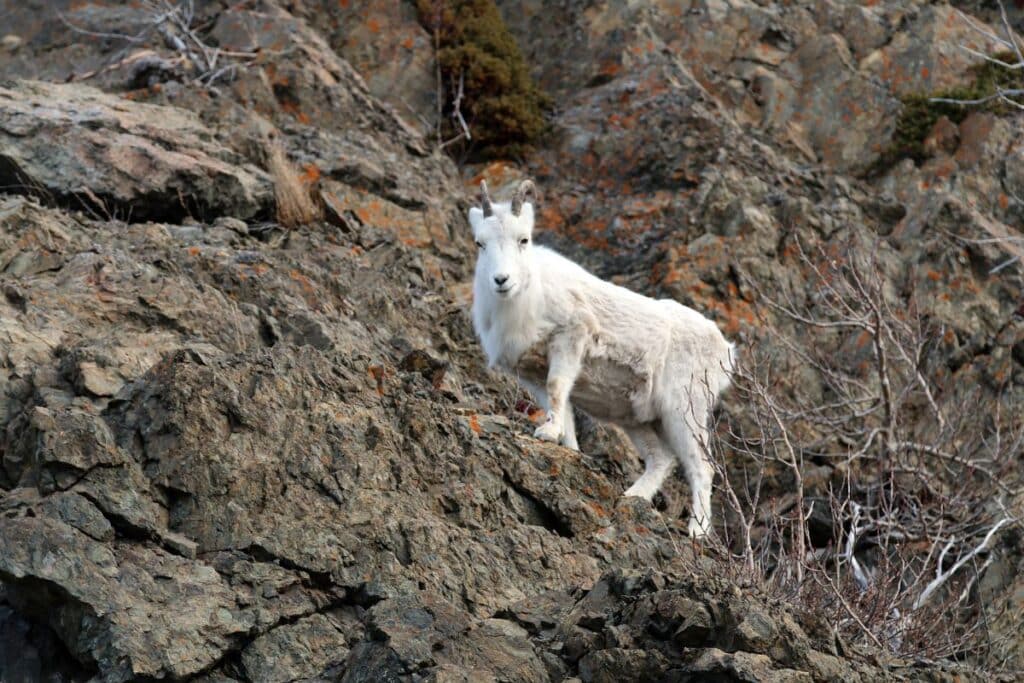
These creatures are distinguished by their stunning white coats and formidable curving horns. Adapted to life in alpine environments, Dall Sheep feed on a variety of vegetation, including grasses, sedges, and lichens, which they find on the windswept slopes and plateaus.
During the rutting season, male Dall Sheep, known as rams, engage in spectacular battles for dominance, their clashing horns echoing through the mountains. These sheep are also an essential food source for the park’s predators, including Golden Eagles, Grizzly Bears, and Gray Wolves, making them an integral part of the park’s food web.
Grizzly Bears
Renowned for their impressive size and strength, Grizzly Bears are one of the top predators in the Gates of the Arctic National Park. These solitary giants roam vast territories, following the ebb and flow of food availability.
In the late spring and summer, Grizzly Bears can often be spotted near riverine areas, foraging for berries or patiently waiting for the salmon spawn. Their omnivorous diet also includes roots, grasses, and small and large mammals.
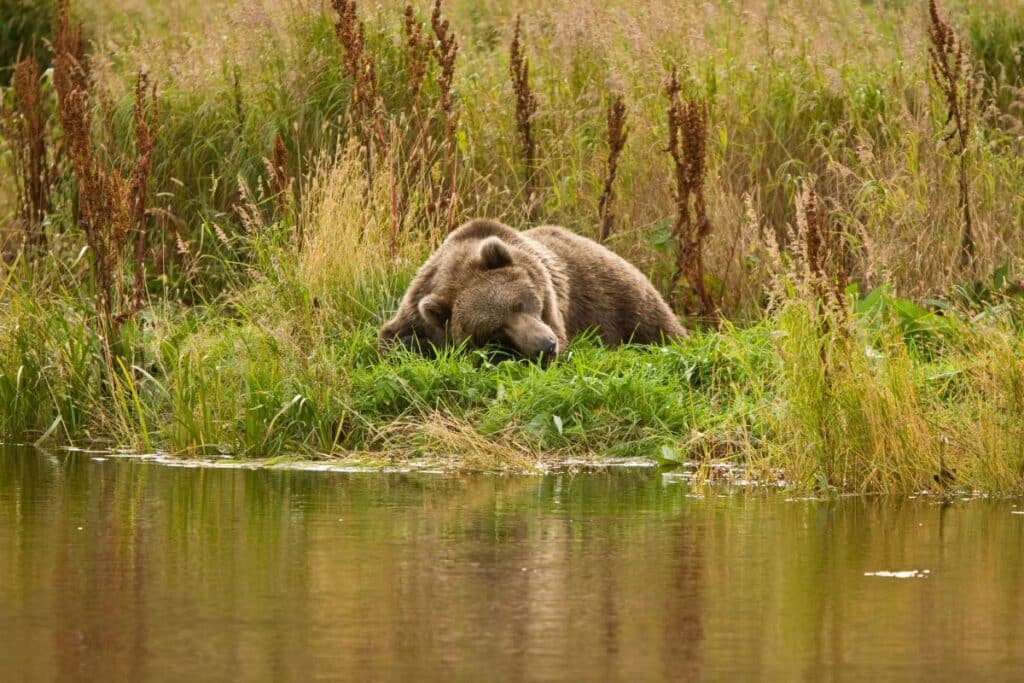
As apex predators, Grizzly Bears play a crucial role in maintaining the park’s ecological balance, helping regulate prey populations and dispersing seeds through their scat.
Encounters with these majestic creatures, while exciting, demand respect and caution, ensuring the safety of both the bear and the observer.
Moose
The Moose, the largest member of the deer family, is a frequent sight in the lower elevations of the Gates of the Arctic National Park.
Often found near bodies of water such as the Noatak, John, and Tinayguk rivers, these large ungulates favor the park’s marshy areas, which provide them with a rich diet of aquatic plants, twigs, and bark.
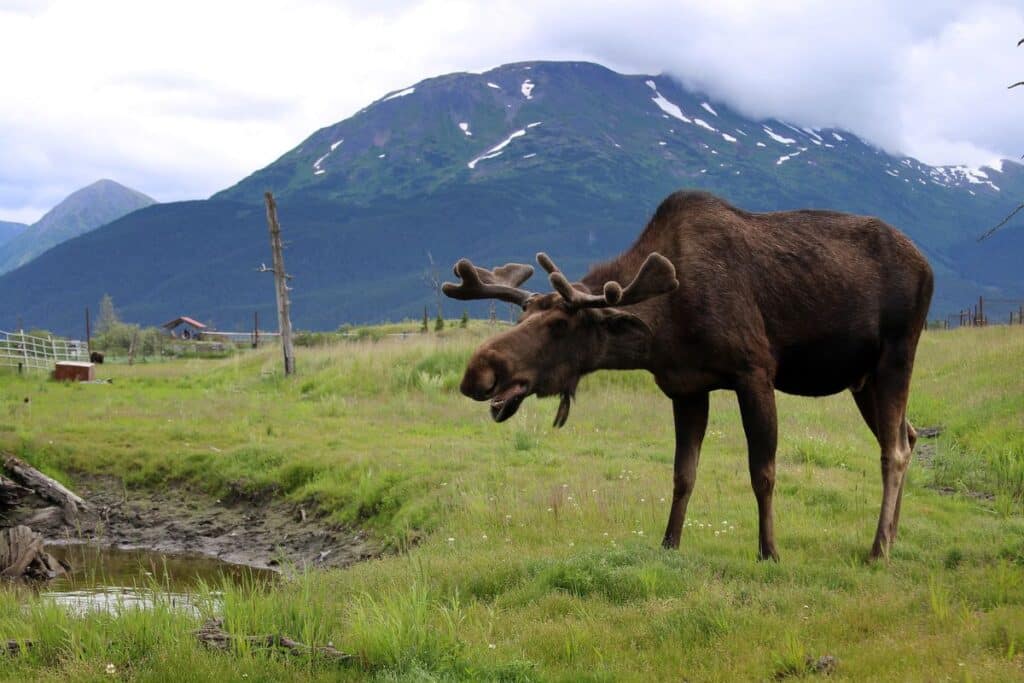
Standing up to 7 feet tall at the shoulder with broad, palmate antlers that can span up to 6 feet, Moose are a remarkable sight. They are not just known for their size but also their agility – capable of swimming several miles and running up to 35 miles per hour.
Moose significantly shape their habitats, controlling the growth of certain plant species through their grazing and providing a vital food source for predators such as wolves and bears.
Arctic Fox
The Arctic Fox is a quintessential resident of the Arctic tundra in the Gates of the Arctic National Park.
With their thick, warm fur that changes color to match the seasons, from snow-white in the winter to brown or gray in the summer, these small mammals are masters of camouflage.
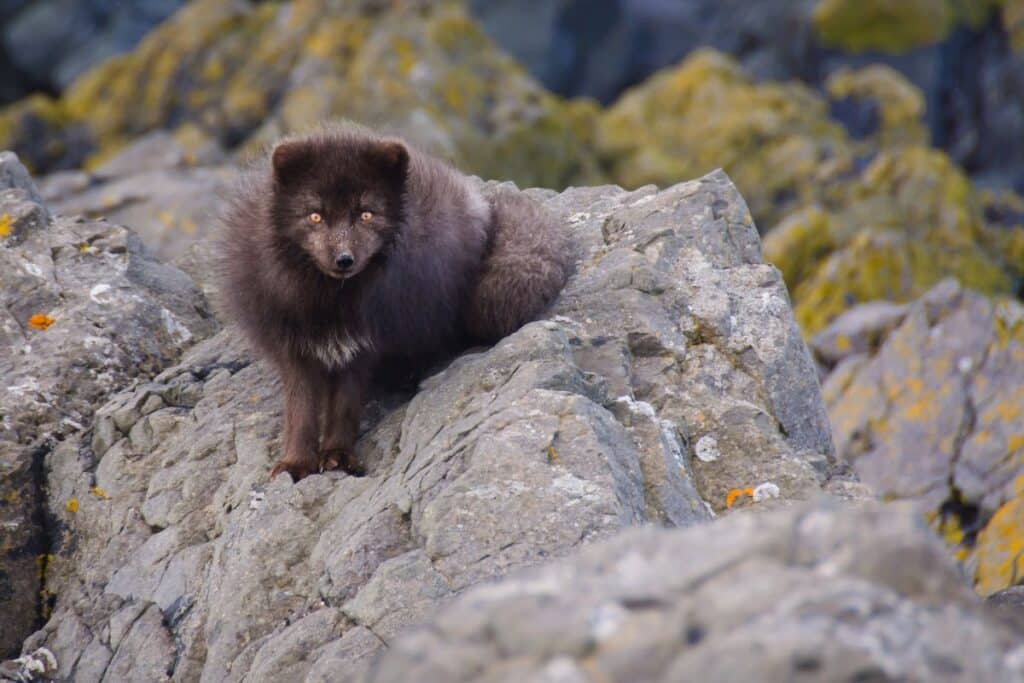
Arctic Foxes are resourceful feeders, preying on lemmings, voles, and seabirds, and scavenging on carrion. They are known for their remarkable adaptability, enduring the frigid Arctic winters with temperatures dropping below -50 degrees Fahrenheit.
Arctic Foxes, although small, play a critical role in the park’s ecosystem, influencing the populations of their prey and serving as prey themselves for larger predators.
Gray Wolf
The Gray Wolf is a symbol of the wild, embodying the untamed wilderness that defines the Gates of the Arctic National Park. They are known for their complex social structures, forming packs that hunt and live together within defined territories.
These territories can span hundreds of square miles, encompassing a variety of habitats across the park. Wolves primarily feed on ungulates like Moose and Caribou, but they also eat smaller mammals and even fish.
As top predators, they play a critical role in maintaining the balance of the park’s ecosystem, controlling ungulate populations and thereby preventing overgrazing.
Despite their significant ecological role, these elusive creatures are often challenging to spot, making any sighting a thrilling experience.
Wolverine
The elusive Wolverine, a symbol of wilderness and resilience, is one of the park’s most impressive inhabitants. Despite their bear-like appearance and reputation for fierceness, Wolverines are the largest members of the weasel family.
They possess a powerful build and a dense, hydrophobic coat that allows them to thrive in the harsh Arctic conditions.
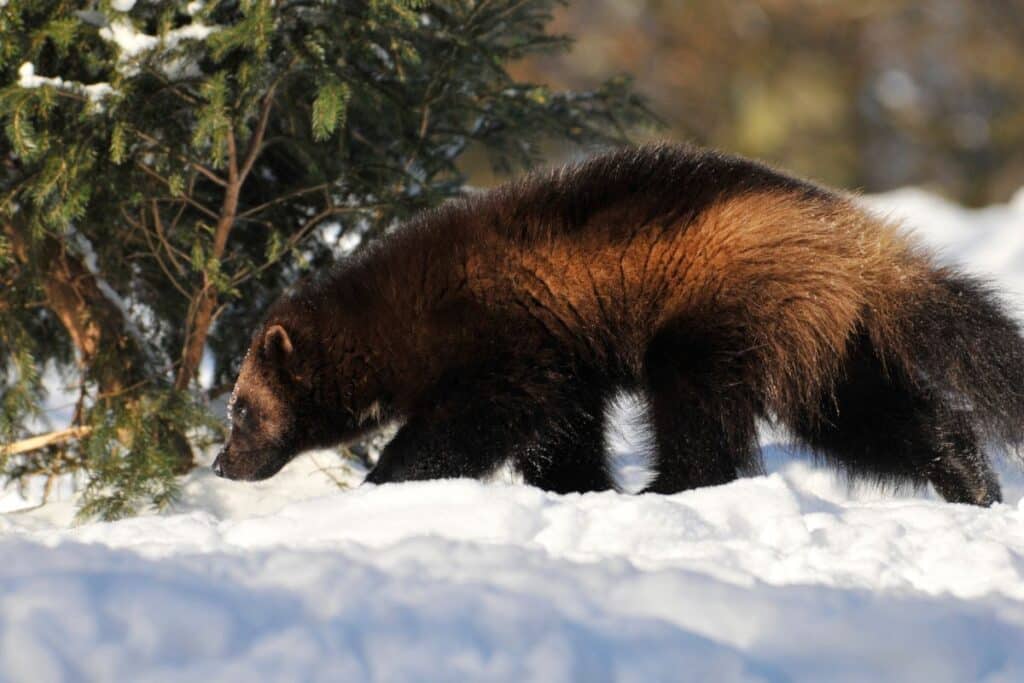
Wolverines are solitary animals, with vast home ranges that can cover hundreds of square miles. They are opportunistic feeders, with a diet that includes everything from small mammals to Moose calves and carrion.
The presence of Wolverines is often considered an indicator of a healthy, functioning ecosystem, reflecting the untouched wilderness of the Gates of the Arctic National Park.
Red Fox
The Red Fox is a smaller, yet equally cunning relative of the Gray Wolf. With its striking auburn coat, bushy tail, and sharp features, the Red Fox is an enchanting sight in the park.
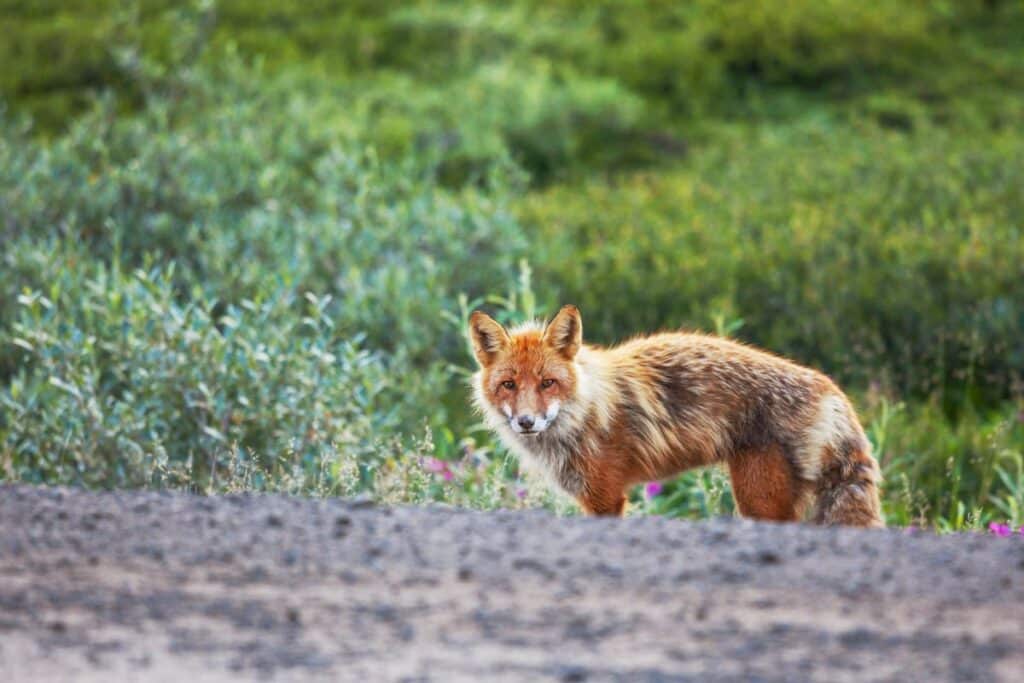
Red Foxes are highly adaptable and can be found in a wide range of habitats, from open tundra to dense forests. They are skilled hunters, feeding on a diet of rodents, rabbits, birds, and other small game, but are also known to consume plant matter.
Red Foxes contribute significantly to the park’s biodiversity, acting as both predator and prey within the ecosystem.
They help control the populations of smaller mammals and provide an essential food source for larger predators.
Snowy Owl
Snowy Owls are iconic residents of the Arctic landscape, well adapted to the park’s extreme winters.
With their almost completely white plumage, these large birds blend seamlessly into the snow-covered landscapes.
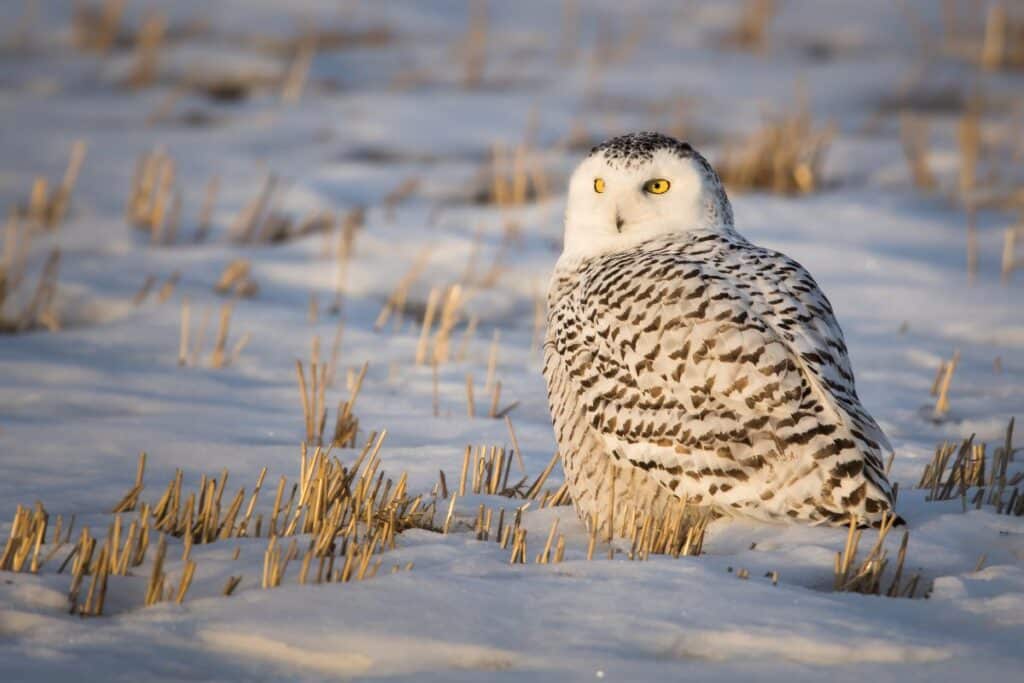
Snowy Owls are mainly found in open areas like tundra and plains, where they can spot and hunt for prey from a distance.
They mainly feed on lemmings and voles, but are also known to take larger prey like geese and rabbits. Their presence is a testament to the park’s robust rodent populations and healthy ecosystems.
Lynx
The Canada Lynx, with its tufted ears, broad paws, and short tail, is an elusive resident of the park’s forests. This solitary cat is specially adapted to hunting in deep snow, preying primarily on Snowshoe Hares.
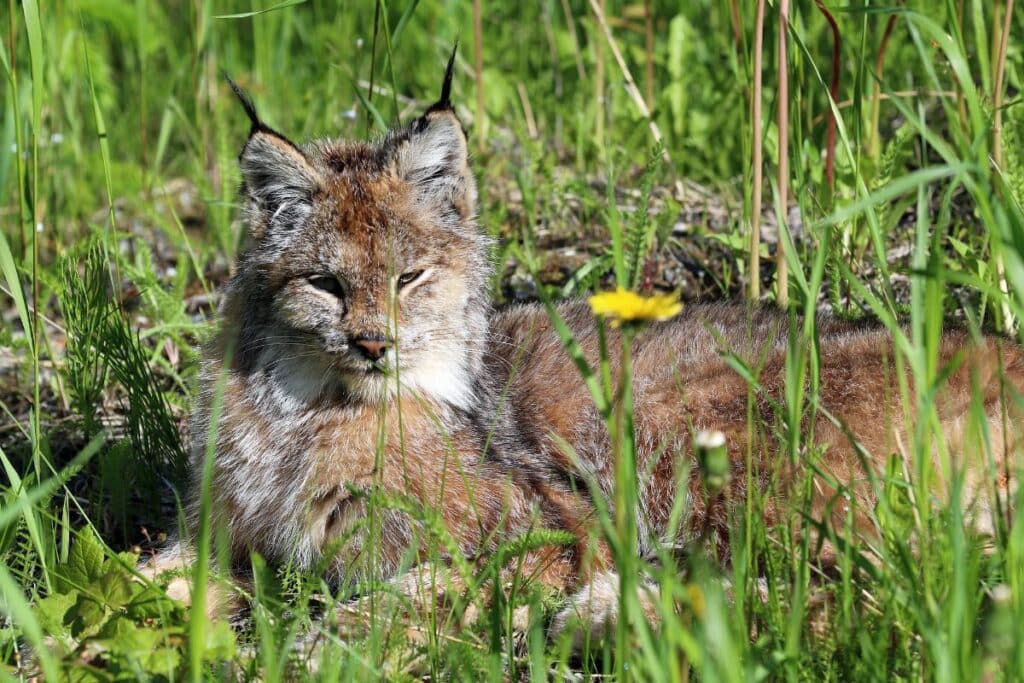
Lynxes play a vital role in the ecosystem, as their population dynamics are closely tied to the cyclical populations of hares, their primary food source. Encounters with Lynxes are rare, but their mysterious presence adds to the park’s sense of untamed wilderness.
Beaver
The industrious Beaver is one of the most remarkable inhabitants of the park’s riparian ecosystems. Beavers are ecosystem engineers, constructing complex dam and lodge systems that create wetlands.
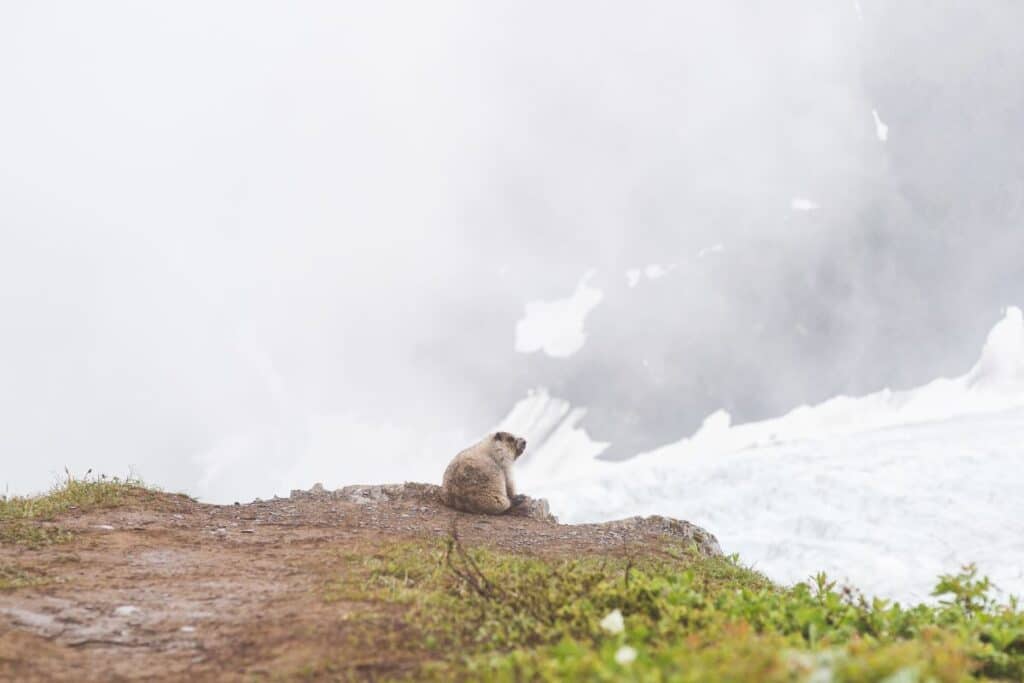
These wetlands offer habitat for a host of species, increasing the park’s biodiversity. Despite being largely nocturnal, Beavers can sometimes be spotted during the day near ponds, rivers, and streams.
Northern Pintail
The Northern Pintail is a graceful waterfowl species that frequents the park’s many lakes and ponds during the summer. These birds are identifiable by their slender necks, pointed tails, and the males’ distinctive plumage.
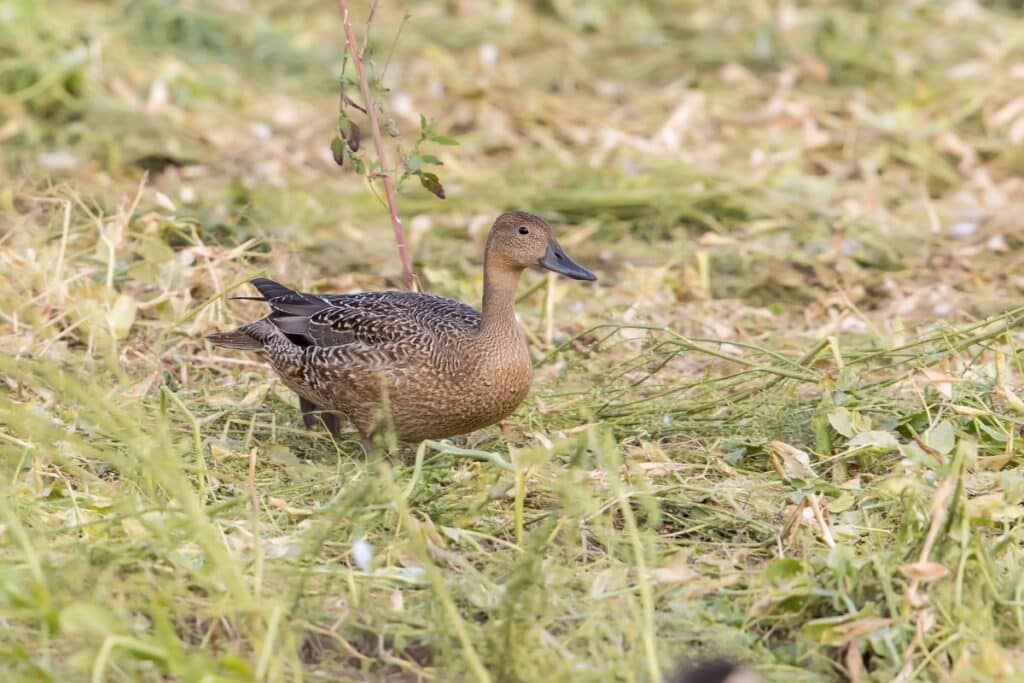
Their presence is a sign of healthy water bodies, as they feed on a diet of aquatic plants and small invertebrates.
Muskrat
The Muskrat, a semi-aquatic rodent, is a common sight in the park’s water bodies. With their dense fur, flattened tail, and webbed hind feet, Muskrats are well adapted to their aquatic lifestyles.
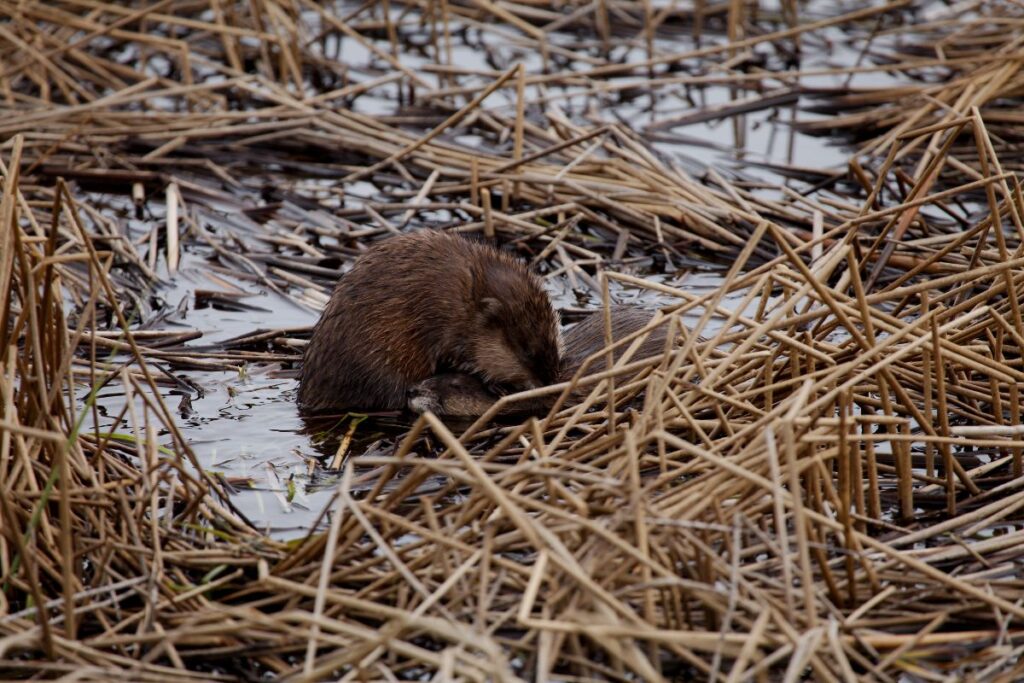
They feed on a variety of aquatic vegetation and play an essential role in shaping their habitat, often constructing lodges of mud and vegetation in ponds and streams.
Peregrine Falcon
Known for its incredible speed and agility, the Peregrine Falcon is a master of the skies. They can often be spotted high above the park, scanning the grounds for prey.
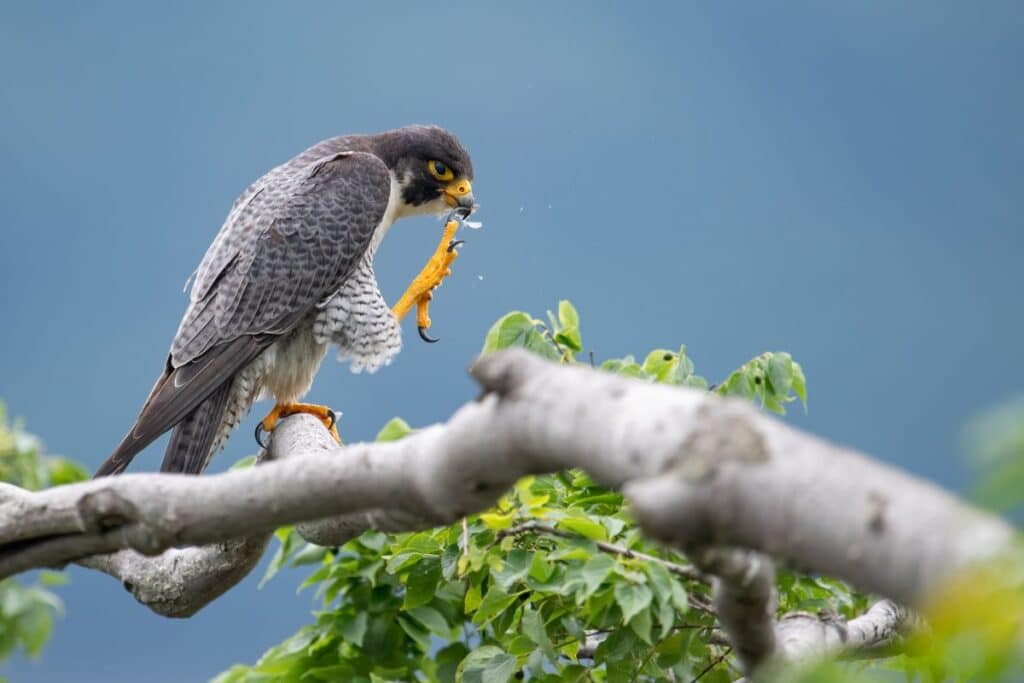
These birds primarily feed on other birds, striking with remarkable precision in mid-air. Their presence is a testament to the park’s rich avian diversity and healthy ecosystems.
Black Bear
The smaller cousin of the Grizzly, the Black Bear, also roams the woods and mountains of Gates of the Arctic National Park. They have a diverse diet, feasting on everything from berries, grass, and roots to fish and small mammals.
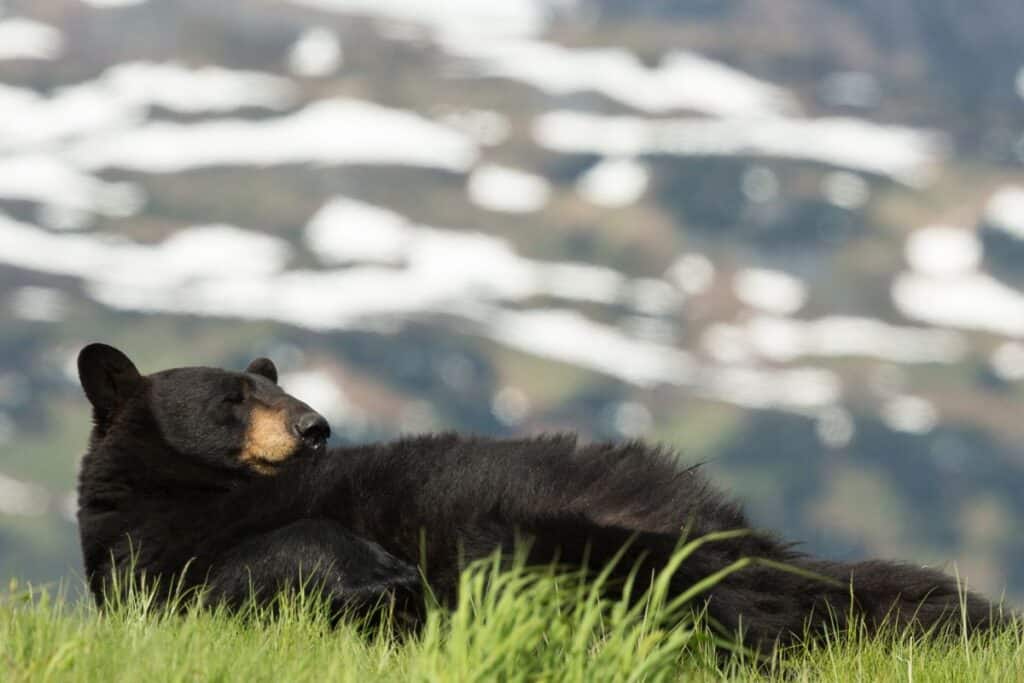
Black Bears are expert climbers and are often spotted in trees, a skill they use to avoid larger predators and find food. As part of the park’s ecosystem, they contribute to the control of insect and rodent populations and play a role in seed dispersal, influencing the park’s vegetation.
Porcupine
The North American Porcupine is one of the largest rodents found in the park. Recognizable by their coat of sharp quills, porcupines are slow-moving and mostly nocturnal.
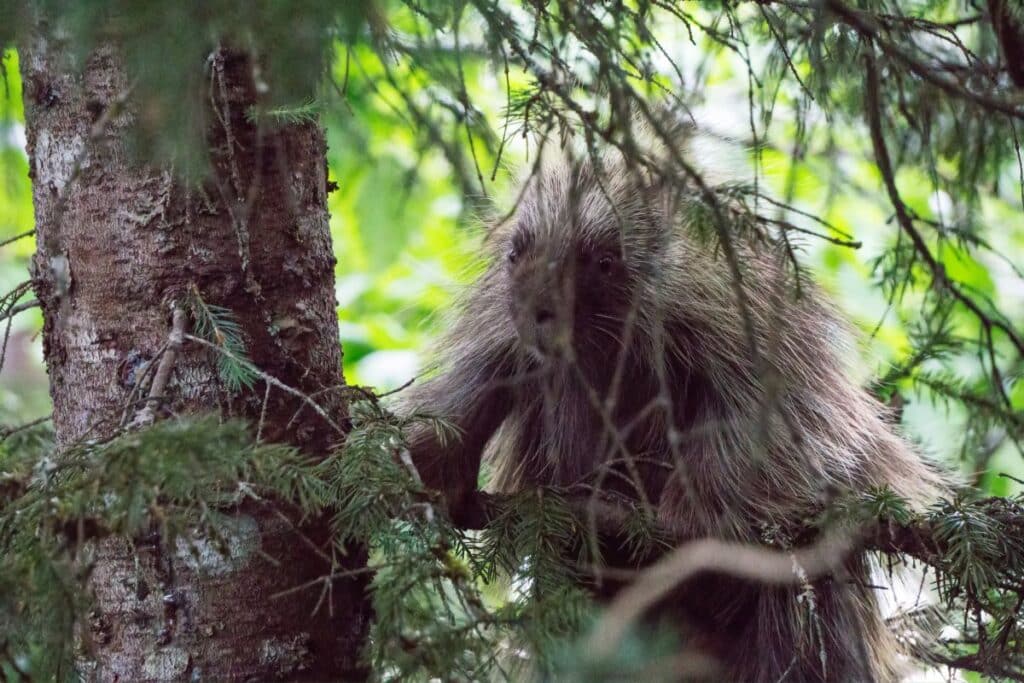
They are often found in trees, feeding on the leaves, twigs, and bark. Their diet significantly influences the vegetation structure of the park, and their quills provide a unique defense mechanism against predators.
Golden Eagle
The Golden Eagle, one of the largest birds of prey in North America, is a majestic sight in the park’s skies. Known for their speed and power, they feed on a variety of mammals including rabbits, ground squirrels, and even larger prey like young Caribou.
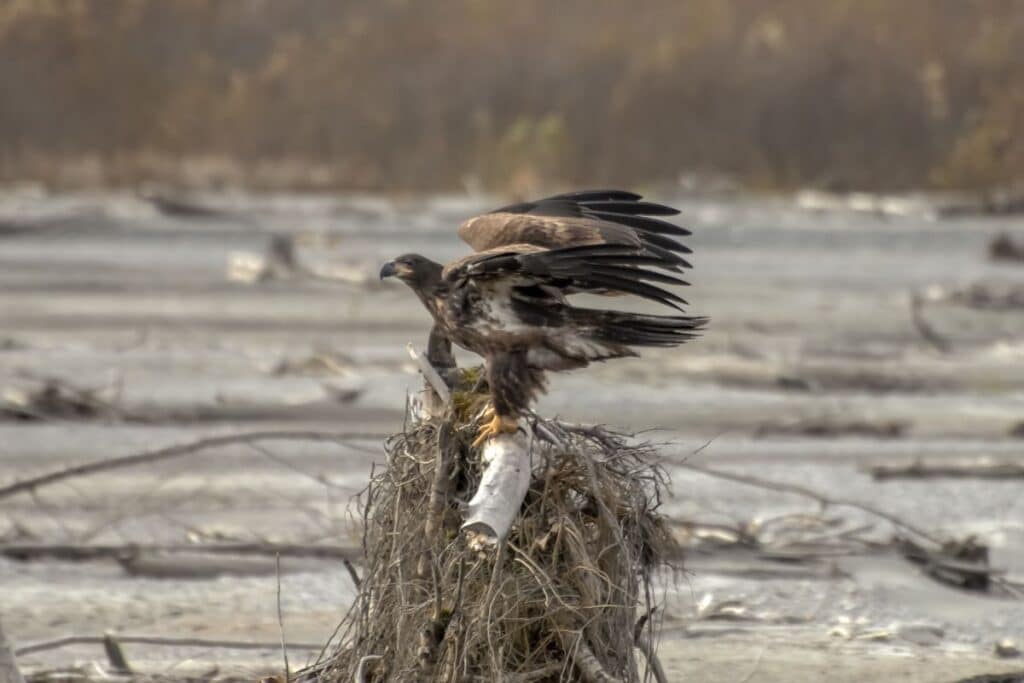
The presence of these skilled hunters speaks to the park’s rich biodiversity and robust small mammal populations.
Northern Hawk-Owl
The Northern Hawk-Owl, a medium-sized owl, is an unusual bird of prey that’s active during the day, unlike most owl species.
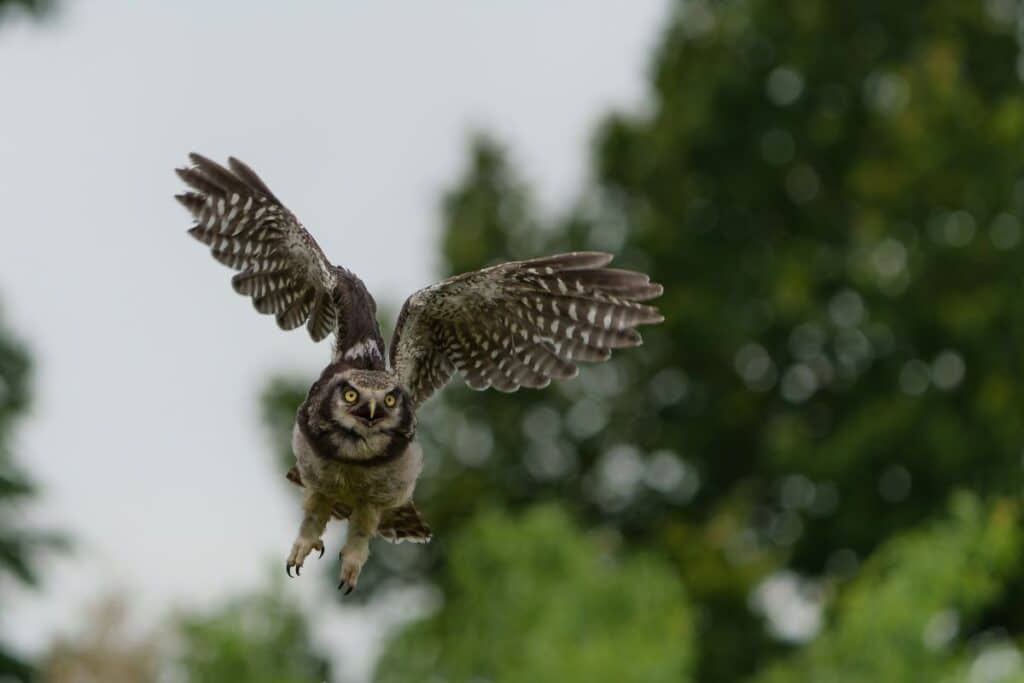
They inhabit the boreal forests of the park and are known for their hawk-like hunting technique, hence their name. Their diet consists mainly of small mammals, making them an integral part of the park’s food chain.
Harlequin Duck
Harlequin Ducks are colorful waterfowl often spotted along the park’s fast-moving rivers and turbulent seacoasts.
These agile swimmers and divers feed on a diet of aquatic insects, mollusks, and small fish. Their breeding and nesting in the park contribute to its diverse birdlife.
Snowshoe Hare
Snowshoe Hares are prevalent in the park, named for their large hind feet that enable them to move quickly over the snow.
These hares are an essential prey species in the park, supporting a range of predators from Lynxes to Golden Eagles. They feed on a wide variety of plant matter, contributing to the regulation of vegetation in the park.
Ptarmigan
The Willow Ptarmigan, Alaska’s state bird, is a fascinating year-round resident of the Gates of the Arctic National Park. These birds are well-adapted to the harsh Arctic environment, possessing feathered feet that act as natural snowshoes.
Ptarmigans are also known for their remarkable camouflage capabilities, with their plumage changing from mottled brown in summer to snow-white in winter.
This transformation helps them evade predators in different seasons. Ptarmigans feed primarily on buds, leaves, and berries, and in winter, they survive on a diet of willow and birch twigs.
Their presence adds to the park’s bird diversity and contributes to the food chain, serving as prey for animals like foxes and raptors.
Gyrfalcon
The Gyrfalcon, the largest falcon species, is a formidable bird of prey that can be spotted in the Gates of the Arctic National Park.
These powerful hunters are built for the harsh Arctic weather, with a thick plumage that insulates them against the cold. Gyrfalcons are known for their high-speed pursuits, hunting a variety of prey from ptarmigans and waterfowl to small mammals.
They are often found nesting on cliff faces and outcrops in the park, reusing nests year after year.
Gyrfalcons play a crucial role in the park’s food web, helping control the populations of their prey species. Their presence in the park underscores the richness and diversity of the park’s avian life.
Wildlife Watching in Gates of the Arctic National Park: Popular Trails
Gates of the Arctic National Park is a pristine wilderness, and unlike many national parks, it has no roads, no trails, and no established campgrounds.
This untouched wilderness makes it a haven for various wildlife species, though it also means there are no traditional hiking trails to follow. The entire park is a backcountry experience, where you make your own trail. However, certain areas are known for their excellent wildlife viewing opportunities.
Arrigetch Peaks Area: This spectacular area, with its jagged peaks and glacier-carved valleys, is frequented by Dall Sheep, Caribou, and various bird species, including Gyrfalcons and Golden Eagles. Adventurous hikers often visit this area for its stunning scenery and abundant wildlife.
Noatak River: The Noatak River corridor, a critical migration route for Caribou, is an excellent area for wildlife observation. Here, you can spot Moose, Beavers, and various waterfowl, including Northern Pintails and Harlequin Ducks.
Kobuk River Valley: This area provides an excellent opportunity to see Brown and Black Bears, especially during the salmon spawn. Also, due to the abundance of small mammals, this is a great place to spot predatory birds like Eagles and Owls.
Alatna River Valley: Known for its beautiful vistas and diverse habitats, the Alatna River Valley is a fantastic area to spot Moose, Wolves, Lynxes, and a variety of birds. The area’s mix of forest and tundra makes it an ideal habitat for a diverse range of species.
To explore Gates of the Arctic National Park, you need to be well-prepared and experienced in wilderness travel. Always remember to maintain a safe distance from wildlife, and respect their natural behavior for your safety and theirs.
Conclusion
Exploring the Gates of the Arctic National Park isn’t just a walk in the park; it’s a journey into the heart of the wilderness, a dive into a world of spectacular landscapes, breathtaking fauna, and an ecosystem that thrives away from human interruption.
From the majestic Caribou moving like poetry across the tundra, the swift and cunning Wolves shadowing their trails, to the dramatic plunge of the Peregrine Falcon from the sky — every moment spent in the park teems with the thrill of the untamed and the unknown.
Imagine standing under the expansive Arctic sky, watching the graceful flight of the Gyrfalcon, or capturing a rare glimpse of the elusive Lynx slinking through the boreal forest.
Picture yourself paddling quietly down the Alatna River, a Beaver busily constructing its dam in the evening sun, or a Black Bear ambling along the riverbank.

